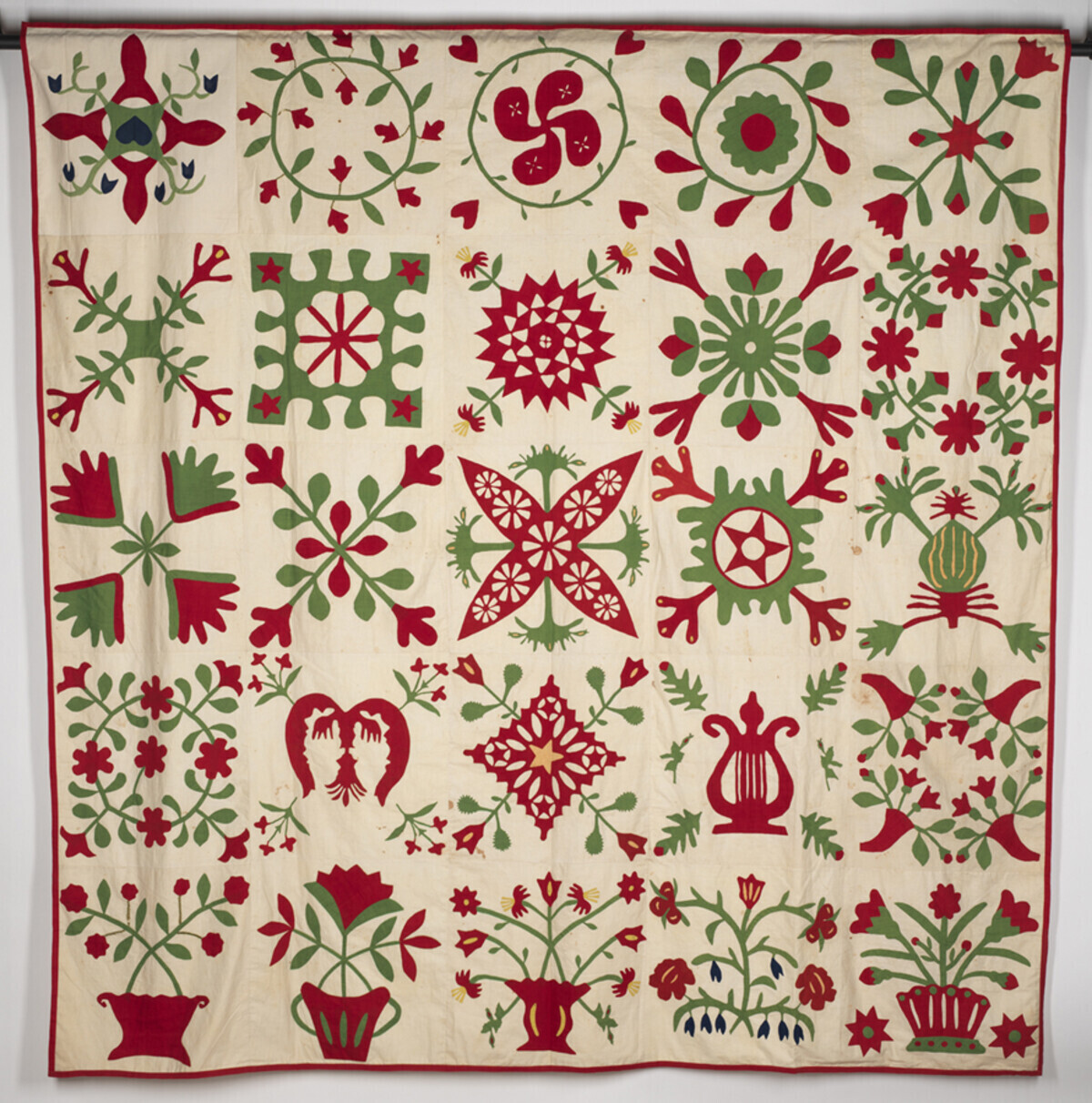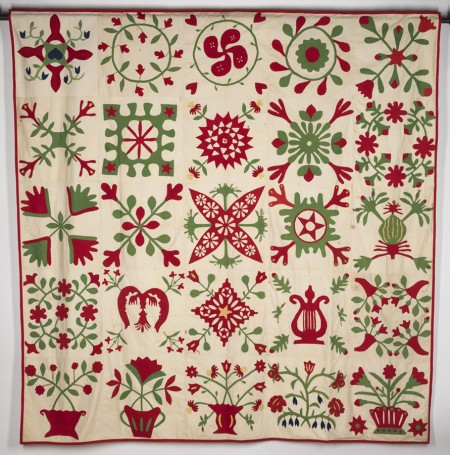 New Exhibition Features 30+ Quilts Made in Western Virginia from 1800 to 1950
New Exhibition Features 30+ Quilts Made in Western Virginia from 1800 to 1950
On Saturday, August 3, 2013, the Virginia Historical Society (VHS) opens The Great Western Virginia Cover-Up: Historic Quilts & Bedcovers. The exhibition presents more than thirty bedcovers—spreads, quilts, coverlets, blankets, and a rare bed rug—made in western Virginia between 1800 and 1950.
Organized by the Blue Ridge Institute & Museum (BRI&M) of Ferrum College, the show examines patterns, methods, and fabrics passed down through generations of Virginia families. The bedcovers displayed are the survivors—the fragile remains of stitching and cloth that did not get ruined by their functional use.
“I can’t think of a better reason to visit a museum than to see a good quilt show,” said VHS lead curator and art historian Dr. William Rasmussen. “The pictures in books or online just don’t do these pieces of art justice, particularly with regard to size and surface detail. Quilt work can be a very strong art form. The quilts on display at the VHS have every bit as much power as a twentieth century painting that utilizes only shapes and colors. In fact, I would argue that some of the covers in this show are as strong—or stronger—works of art than many of those paintings.”
Natalie Norris, a quilt collector and historian, curated the exhibition with assistance from appraiser and consultant Neva Hart. BRI&M Assistant Director Vaughan Webb said research for the show included “a great deal of detective work” to determine origins, dates, and fabric types. Most of the objects on display are from private collections and have never been included in a public exhibition.
“What museum visitors see in this show are the few samples that remain that a family member realized were special,” Webb said. “These are the quilts that didn’t get used up.”
The exhibition features bedcovers with familiar patterns, such as Flying Geese, Log Cabin, Pinwheel, Virginia Rose, Whitework, Crazy, and Pieced. There is an 1833 bed rug on display, one of only five surviving bed rugs known today. It also includes printed cotton animal feed sacks used for making everything from clothing to quilts to dish towels, an 1830s doll bed, a wooden quilting frame, a child’s sewing machine, a chicken-shaped thread holder, and a pin cushion in the form of a woman’s shoe.
Many of the pieces displayed include information about the creators and/or owners. Highlights include a fan quilt made by ballad singer Texas Gladden of Roanoke County, who was recorded by famed musicologist Alan Lomax for the Library of Congress; a quilt presented to Reverend James Goode Lane Hash in 1921 by the women of Patrick County for his work as a advocate for the people of the mountains (including marrying couples at their mailbox and testifying as a character witness for moonshiners); and a cover embroidered with the name Eli Metzger, a still-unknown man thought to be the possible future husband of creator Barbara Ulrey Roat until she married someone else in 1892.
“It is important for people interested in this state’s past to realize what an expansive body of artistic expression can be found in this medium,” Webb added. “Bedcover motifs and techniques traveled across great distances and crossed social and economic strata. This exhibition will help expand people’s appreciation of Virginia quilting history.”
The Great Western Virginia Cover-Up: Historic Quilts & Bedcovers is on display for free at the VHS until January 5, 2014. The VHS is currently the only site other than the BRI&M scheduled to host the show before the materials are returned to private hands.
VHS programming accompanying the display includes a noon-time lecture on August 22 called “War and Pieces: Quilts through America’s War Years” by exhibition consultant Neva Hart, and a historian-led guided tour of the exhibition at noon on October 16.
The society is also hosting a free Quilt Documentation & Discovery Day from 10 a.m. to 4 p.m. on Saturday, September 28. Quilt owners are encouraged to bring quilts made before 2000 to the VHS. Virginia Consortium of Quilters will be photographing and recording information about the pieces and their makers for a statewide database maintained by the Virginia Quilt Museum in Harrisonburg.
“The precision of sewing is extraordinary,” Rasmussen said. “How did they conceive the design? How did they execute their idea with such crispness and clarity? I wasn’t planning to stop and think so much about elements like stitching and fabric. But when I really looked, the subtleties of the geometry fighting against the organic shapes make the pieces seem as if they are energized and ready to come to life.”
# # #
For more than 182 years, the Virginia Historical Society (VHS) has been connecting people to America’s past through the unparalleled story of Virginia. The VHS—a history museum and research library—features award-winning exhibitions that are entertaining and educational for visitors of all ages. The Society is the only museum with all of Virginia’s history under one roof—all centuries, all regions, and all topics are covered. Although designated the Official State Historical Society, the VHS is a privately funded non-profit organization that relies on contributions from individuals, corporations, and foundations to sustain its operations. The VHS is located at 428 North Boulevard in Richmond’s Museum District. Admission is free. Museum hours are Monday–Saturday 10 a.m.–5 p.m. and Sunday 1 p.m.–5 p.m. Library hours are Monday–Saturday 10 a.m.–5 p.m. For more information, call (804) 358-4901, visit www.vahistorical.org, or find the VHS on Facebook and Twitter.





